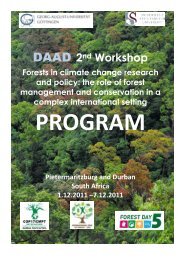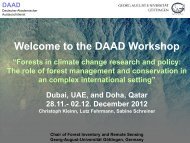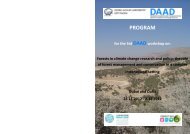Proceedings of the Workshop - Georg-August-Universität Göttingen
Proceedings of the Workshop - Georg-August-Universität Göttingen
Proceedings of the Workshop - Georg-August-Universität Göttingen
Create successful ePaper yourself
Turn your PDF publications into a flip-book with our unique Google optimized e-Paper software.
In this context buffer zones are defined as any area peripheral to a protected<br />
area, in which activities are implemented that aim at enhancing <strong>the</strong> positive and<br />
reducing <strong>the</strong> negative impacts <strong>of</strong> conservation on neighbouring communities and <strong>of</strong><br />
neighbouring communities on conservation efforts (Ebregt & DeGreve 2000). Some<br />
land uses, such as forestry or agro-forestry are particularly suitable for buffer zone<br />
management. These land use systems are potentially beneficial for <strong>the</strong> ability <strong>of</strong> wild<br />
life species to move through changing landscapes. Benefits may also result for human<br />
populations that rely on natural resources and on regulating services provided by<br />
(agro-) ecosystems, which are resilient to impacts from climate change (Dudley et al.<br />
2010). However to be effective, <strong>the</strong>se areas must be <strong>of</strong> sufficient size (Hagerman &<br />
Chan 2009), and landowners must be willing to adjust <strong>the</strong>ir activities to have <strong>the</strong> least<br />
impact on <strong>the</strong> natural resources as possible. Conservation cannot be separated from<br />
issues relating to human wellbeing, and those involved in conservation are usually also<br />
concerned with social justice and sustainable development (WWF 2004).<br />
The project AMISCONDE (Amistad, Conservación y Desarrollo - Friendship,<br />
Conservation and Development) was a conservation and development initiative in <strong>the</strong><br />
buffer zone <strong>of</strong> <strong>the</strong> La Amistad Biosphere Reserve (ABR), executed between 1992-2007<br />
with <strong>the</strong> aim to promote communities’ sustainable development and to improve <strong>the</strong><br />
local peoples’ quality <strong>of</strong> life in <strong>the</strong> buffer areas <strong>of</strong> <strong>the</strong> ABR, reducing pressure on natural<br />
resources <strong>of</strong> protected areas (Granda & Jiménez 2002). This project was implemented<br />
by Conservation International and <strong>the</strong> Tropical Science Center (Murillo 2007) and in 23<br />
communities in <strong>the</strong> buffer zone <strong>of</strong> <strong>the</strong> ABR (Fehler! Verweisquelle konnte nicht<br />
gefunden werden.). During those years a broad range <strong>of</strong> strategies were implemented<br />
with <strong>the</strong> goal <strong>of</strong> ensuring sustainability among <strong>the</strong> development <strong>of</strong> rural communities<br />
and <strong>the</strong> environment. It has become evident that many <strong>of</strong> <strong>the</strong>se measures such as<br />
environmental education, reforestation and biological monitoring, among o<strong>the</strong>rs,<br />
overlap with some <strong>of</strong> <strong>the</strong> strategies currently promoted by Costa Rica’s government as<br />
part <strong>of</strong> <strong>the</strong> National Climate Change Strategy.<br />
This paper aims to present a variety <strong>of</strong> climate change adaptation and mitigation<br />
strategies which have effectively been implemented by <strong>the</strong> AMISCONDE project<br />
between 2004- 2007 and to discuss <strong>the</strong> lessons learned during this process. This<br />
information can serve as a basis for future initiatives in protected area buffer zones in<br />
tropical areas within <strong>the</strong> context <strong>of</strong> biodiversity conservation and climate change<br />
adaptation and mitigation policies.<br />
2. Material & Methods<br />
2.1. Study area<br />
The AMISCONDE project was implemented between 1992 and 2007 in 23 rural<br />
communities located within <strong>the</strong> bufferzone <strong>of</strong> <strong>the</strong> Amistad Biosphere Reserve (ABR),<br />
between <strong>the</strong> geographical coordinates 9º24’26’’N and 82º56’20’’W. This reserve covers<br />
an area <strong>of</strong> 567,845 hectares, ranging in elevation from sea level to 3820 m.a.s.l. (see<br />
Fehler! Verweisquelle konnte nicht gefunden werden.). Most <strong>of</strong> its area is located in<br />
<strong>the</strong> Tropical Montane Rain Forest life zone according to Holdridge (1947). Land use in<br />
<strong>the</strong> study area is dominated by small holder shade grown c<strong>of</strong>fee farms, dairy farming,<br />
subsistence agriculture, and fragmented primary and secondary forests.<br />
2.2. Governmental and private Partners <strong>of</strong> <strong>the</strong> AMISCONDE Project<br />
An important aspect <strong>of</strong> <strong>the</strong> project’s strategy consisted in its participatory approach, as<br />
it involved different governmental institutions, NGOs, and local groups as project<br />
partners, with <strong>the</strong> aim to achieve sustainability in time <strong>of</strong> <strong>the</strong> actions promoted. These<br />
partners contributed directly to <strong>the</strong> implementation <strong>of</strong> <strong>the</strong> project by facilitating<br />
coordination and co-execution <strong>of</strong> related activities in <strong>the</strong> focal communities in which<br />
‐ 34 -










